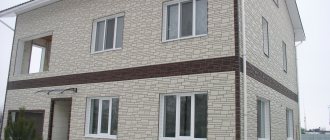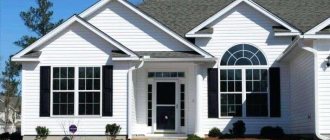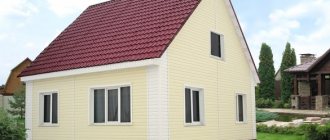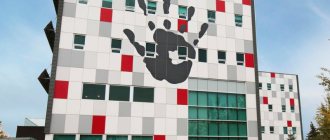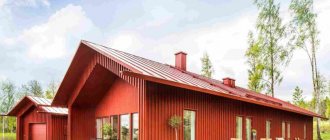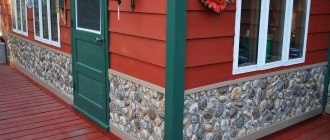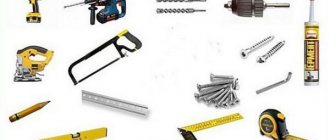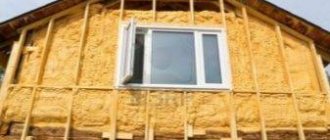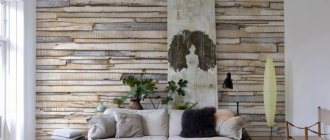Vinyl siding is decorative panels that are used for exterior and interior decoration of residential buildings, administrative buildings, industrial facilities, and household premises. It has earned its popularity due to its optimal physical and mechanical properties, affordability and ease of installation. The combination of decorativeness, practicality and versatility allows the products to be widely used for cladding respectable facades or parts thereof, and creating stylish interiors.
Vinyl siding - what is it?
Vinyl siding for exterior finishing
Panels for exterior finishing of buildings are a horizontal plate of millimeter thickness with fastening in the form of locks located along the long edges. For ease of installation, there is perforation on the top edge. The shape of the panels is no different from the first wood siding invented in the 19th century .
Appearance of vinyl siding panel
The elements are installed sequentially, starting from the bottom. The panel is attached to the wall or sheathing and the next slab is connected to it with locks and mounted to the base in its upper part.
Each element is attached above the sheet placed below with a slight overlap, which prevents precipitation from reaching the walls
How is siding fastened?
Each panel is equipped with two locks - upper and lower. There is only one for the start and finish bars. The lock is the curved part of the panel that secures them to each other. The first row is attached to the starting bar, the second to the first, etc. to the top panel. The lower lock is the lower edge, the upper one is located below the fastenings for self-tapping screws. The place where the panel is attached to the sheathing is covered by the next row of panels.
Sequencing:
- The lower lock is combined with the upper lock of the previous row or starting bar;
- The upper edge is fixed to the sheathing;
- The entire row is mounted;
- The slab of the next row is secured with locks.
The panels are mounted one above the other, starting from the starting strip - it serves as a guide for a smooth facade. The lining for external use is attached to the sheathing using self-tapping screws or special brackets. The self-tapping screw should not fit tightly - there should be a gap of about 1 mm (the thickness of a coin) between its head and the surface. The fastening points are spaced 30cm from each other, this value may vary depending on the characteristics of the material.
The wall panels are attached with an overlap (unlike the starting panels, between which there is a gap). Due to thermal expansion, this will not affect the characteristics of the coating. To prevent thermal expansion from damaging the slabs, each fastener is installed strictly in the middle of the hole intended for it.
It is important that it is perpendicular to the wall. For window openings and doors you need to leave a gap - for this the panels have to be cut
Production
Mass production of vinyl siding began about 70 years ago, with the invention of new materials during the chemical industry revolution. PVC siding consists of 80% polyvinyl chloride , which is obtained by coextrusion (combining molecules) of oil and chlorine. The new material has improved properties.
Creation of siding panels in the factory
To produce panels, polyvinyl chloride in combination with pigments, chalk, modifying and stabilizing additives is passed through special equipment that gives the planks the desired texture, and then, using a calibrating machine, the products acquire their final shape.
Vinyl siding forming machine
In the edges of the plank, a special machine punches holes for fastenings and cuts it into panels of the required size: 250-400x20-30x0.09x0.12 cm.
The base (bottom layer) of the panel is vinyl - a mixture of calcium carbonate and polyvinyl chloride. The base of PVC panels is responsible for the strength and heat-shielding properties of the material, and also retains the shape of the products. In the production of slabs, it is permissible to use recycled material in a small percentage. If more recyclable materials are added, this significantly deteriorates the quality of the slabs.
The price of panels depends on the quality of their base
The outer layer of vinyl siding protects the base surface from ultraviolet rays, temperature changes and aggressive influences of the natural environment. Special additives preserve the color of the material for a long time under extreme conditions and prevent the slabs from delaminating, deforming and peeling.
Vinyl siding prices
Vinyl siding
Video - Vinyl siding production
What to consider when purchasing material
Vinyl siding: how to choose, what you pay attention to
Here are a few recommendations that you should take note of when purchasing this finishing material:
- Buy only material from recognized manufacturers who provide a long warranty period for their product. Also, the components must be manufactured by the same company as the panels themselves.
- The color of the front and inner surfaces of the panels must match.
- The uniform thickness of this material is determined by the side cut of the siding. Typically the panels have a thickness of 1-1.1 mm.
Note! Thicker siding does not have increased strength and quality, as it might seem at first glance - on the contrary, it is more easily deformed due to its low elasticity.
- The mounting holes must be the same size and the edges must be smooth.
- The color and texture of the front surface must be uniform; the presence of unevenness, roughness and cracks is unacceptable.
Note. Such defects do not appear on vinyl siding even after a long period of use, and if they are found on new panels, this clearly indicates extremely low quality.
Characteristics and properties of the material
Wide slabs with a relief texture imitating wood and other surfaces consist of:
- 70-80% polyvinyl chloride;
- 15% calcium carbonate;
- 10% titanium dioxide;
- 1% butadiene;
- lubricants and pigment additives.
The thickness of vinyl boards depends on their type and ranges from 0.9 to 1.2 mm.
The thicker the siding, the more reliable the finish will be.
Temperature resistance limit of the material – 88 ℃.
Main properties of vinyl siding:
- The material does not ignite when heated, is resistant to fire, and begins to melt under the influence of high temperatures.
- The plates have good compression. They contract and expand under the influence of temperatures, which ensures the stability of the façade.
- If you choose the right coating, it will be able to withstand any negative environmental influences.
- Vinyl siding is not afraid of alkaline substances.
- Under the sun's rays, temperature changes and precipitation, the siding does not fade, does not rust, does not rot or deform.
The material can easily withstand hail and heavy winds.
Vinyl panels for exterior decoration, or rather one of the methods of their installation, makes it possible to insulate external walls
Siding production
Types of siding fasteners.
The raw material for making vinyl siding is called a compound. It consists of vinyl (plastic) powder, called powder, and technological additives (modifiers, stabilizers) that provide the required properties. For example, additives that stop the aging of plastic ensure stable properties throughout the entire period of operation. There are additives that prevent delamination, cracking, swelling, and burnout. A set of certain ingredients allows you to vary the properties of vinyl siding and produce panels for different operating temperatures, with different strength, durability, and resistance to aggressive environments.
The heated mixture of compound and coloring pigment is squeezed out through a gap that determines the shape of the siding surface (the number of slats, their width, the contour of the recesses). Immediately after extrusion, the surface is processed with a textured roller to imitate the desired look (cut of wood, stone) and then cooled in a vacuum device. After applying the texture, the edges of the panel are cut to align the edges. The necessary technological perforation is made.
Why is siding interesting?
The name "siding" is of English origin. This finishing material borrowed its name from the English word side. The main functions of the material are to protect the external walls of the building from the negative influences of the environment and ensure the aesthetic appeal of the building.
Vinyl siding provides the consumer with a wide choice of textures and colors to suit any exterior
Vinyl siding panels are similar to lining not only in appearance, but also in the installation method. After installation, the slabs form a single structure.
The material is not 100% airtight, otherwise the base surface underneath would become unusable from the condensation that forms. Ventilation holes on the slabs are provided to ventilate the inside of the wall cake and remove moisture.
Plates with perforation for condensate drainage
Vinyl siding is very easy to maintain and has a fairly long service life (up to 50 years or more) . The material is easy to clean and is not afraid of chemicals.
Fiber cement siding
The material is a universal facade finishing made on the basis of fiber cement - cement with the addition of quartz sand and cellulose fiber. As a result of pressing and heat treatment, the composition acquires extraordinary strength, and due to the dyeing cycle included in the production process, it acquires the desired color.
Today, two types of fiber cement siding are available for exterior cladding:
- wide boards;
- rectangular panels.
Fiber siding is highly resistant to external influences and damage. Cladding is an environmentally friendly, non-combustible material, which attracts the attention of many homeowners.
Types and characteristics
One of the varieties of vinyl siding is acrylic material of the same name. It is much stronger, has higher performance characteristics and temperature stability limits, and is not afraid of shocks and other mechanical influences.
Exterior siding can have a different appearance
According to their purpose, siding can be wall, basement and soffit.
Wall siding
The panels are used for cladding the external walls of a building.
According to the form factor they have the following varieties :
- block house (with imitation of a log house);
- “ship plank” or false timber (a variety that completely imitates a timber façade);
- lining (in appearance it does not differ from the usual panels for interior decoration);
- herringbone (single, double or triple panels).
Depending on the installation method, wall siding can be horizontal or vertical.
An example of vertical wall siding on the facade of a house
Vinyl siding is connected in different ways: tongue-and-groove, quarter, butt, overlap and plank. According to the configuration of the panels, there are one-, two- and three-fracture panels.
An example of single-fracture and double-fracture siding
When installing wall panels, additional elements are also used - external and internal corners, profiles and starting strips.
Plinth panels
This type of material is intended for finishing the basement part of the foundation. It differs from wall siding in thickness and dimensions. The shape of the panels is rectangular, the height is equal to the plinth standard, and the thickness is 2 times that of the wall.
The elements can withstand heavy loads. The material is impact-resistant, resistant to mechanical stress, does not absorb moisture and does not freeze. It is not afraid of exposure to chemical agents and does not deform when the soil heaves.
An example of basement siding on the facade of a house
Basement siding materials:
- vinyl,
- fiber cement,
- acrylic,
- Cink Steel.
The most common slab sizes are 135x155x3 cm . Basement siding can be made with imitation brick, stone or wood.
Soffits
This variety is used for hemming eaves overhangs and other horizontal surfaces. The panels can be solid or have perforations for additional ventilation of the facade. Mostly found in white or brown, their main function is to hide areas of roof overhangs and eaves from prying eyes. They can also be used to decorate the ceiling of a porch or gazebo.
Exterior view of vinyl soffits in the porch ceiling of a house
Soffits may have perforation in the middle, over the entire surface, or be completely absent.
Prices for different types of spotlights
Roof soffits
Video - Review of facade materials: vinyl siding and plinth panel
Types of siding
The material has many varieties.
First of all, it is necessary to distinguish:
- Basement siding. Initially, it was created for cladding the lower (basement) part of the building, but practice very quickly gave it equal rights with the main type - facade. The reasons for this were the high decorative qualities of the material, mainly specializing in imitation of various types of stone or brickwork, as well as the strength and ease of installation work.
- Facade (wall) siding. The main cladding used to finish all external parts of the building - walls, gables, attics, soffits, etc.
In addition, for wall panels there is a division into:
- Vertical. The panels are arranged in a vertical orientation and installed from left to right (or vice versa). Stonework is often imitated.
- Horizontal. The main type, the panels are horizontal and fastened from bottom to top. The main imitation is wood.
NOTE! Notable is the fact that facade types of siding, as a rule, imitate walls made of wood - timber, logs, ship planks, while basement types predominantly imitate stone (or brick) masonry.
The most important division of material is the type of material.
Today there are samples from the following materials:
- Wood.
- Metal.
- Plastic.
- Fiber cement.
At the same time, all materials have their own subtypes - for example, wood siding can be made from pressed or stabilized wood, plastic siding has acrylic or vinyl types, etc. All properties of panels of the same type are usually the same, which gives reason to talk about them as a single group.
Design and colors
Basically, vinyl panels for facade cladding are supplied in pastel, neutral and soothing colors.
If operating conditions are violated, any finishing material can fail
They are:
- pink,
- beige,
- white,
- light green,
- light brown
- light gray.
Colored siding in delicate shades is produced by mixing a coloring pigment into a white molten composition.
Basic colors of vinyl siding
There are also bright colors of panels - blue, red, orange, cherry , etc. The technology for their production is slightly different from the colors described above, and the range of choice is slightly smaller due to the not so wide popularity of the cladding.
Siding panels in bright colors have a shiny glossy surface
There is vinyl siding with an exact imitation of the texture of wood, brickwork or stone.
Vinyl siding with wood imitation for facade decoration
The most common slab design in our regions is a block house and log siding.
Photos of beautiful examples of finishing houses with siding
The editors of the site stroim-dom.net have selected for you several attractive options for the design and style of your home. Light pink tones at home will never irritate you and can create a light and calm environment.
Photo of finishing with slatted vinyl siding
The option of finishing with slatted vinyl siding will make you stand out among all the houses; it will look especially creative together with imitation masonry siding; in this case, it is used to finish the base. From a distance, it is practically indistinguishable from shipboard, the finishing of which would cost simply “cosmic” money.
Photo of finishing in English style
For those who want the house to look expensive and rich, you can use white siding; this will give the house elegance and allow it to fit into any modern design, similar to the English style.
Photo of imitation rounded timber
If the house is located in the middle of a forest, you can choose an imitation of rounded logs as decoration; your house will look like a fairy-tale mansion.
Photo of partial finishing of the house with siding
Partial use of siding to highlight certain details of the home will help give the house an original appearance.
In order for your home to be original, you should carefully consider the choice of colors; contrasting shades will look great in pairs, you will be able to stand out among many gray houses and give a unique look to your home.
Which siding is better: features of choice
It is difficult to give an objective assessment of this material and determine which type is better: it all depends on the needs, scope of application and personal preferences. Some people like rich blue wall panels, while others want a brick-like plinth finish.
When choosing siding for cladding your house, take into account the climatic features of the region
Tips for choosing vinyl siding:
- Choose the type of product depending on the needs and climatic characteristics of the region.
- When the choice is made on a specific type, be sure to check the availability of components and additional elements of the same color.
- Pay attention to the quality of the panels and the ability to withstand uniform loads. The thickness of the slab should be the same along its entire length and width.
- Before purchasing, check the slabs for plasticity. Fold the small edge at the edge of the panel. If it breaks, it is better to refuse the purchase.
- Do not ignore the siding storage conditions. The condition in which the material is in the warehouse will tell you a lot.
- If it is not possible to purchase everything you need at once, you should not buy siding in parts.
Remember : like any piece of finishing material, vinyl siding from different batches may vary slightly in color. This is a significant drawback, since such a difference is clearly visible directly on the facade.
Truly high-quality items have appropriate packaging. The manufacturer takes care of the safety of products so that the material is not damaged during transportation and storage.
The color of the purchased siding on the front and back sides must be the same
Types of vinyl panels
Vinyl cladding material can be classified according to different criteria.
Depending on the color design, polyvinyl chloride panels can be:
- pastel colors;
- white;
- colored.
By location of siding slabs:
- horizontal;
- vertical.
Since vinyl siding boards can have different textures, they are usually classified according to what natural material they imitate :
- stone. There are differences in the structure of the stone;
- tree. Imitates various tree species: pine, spruce, oak;
- brick. Brickwork can be of different colors and configurations.
The outer coating is also defined as smooth and textured.
There are also such types of siding as:
- Fineber;
- Tecos;
- Deke;
- Under a log;
- Under a stone;
- Ship board.
Equipment
In order to simplify the installation of siding panels in difficult places and also to ensure that the image of the facade after installation of the material is complete, additional parts and other accessories are used. They are used to frame door and window openings, as well as decorative projections or niches. Special elements are used in the design of the pediment and lower roof hangers, joining points and all kinds of transitions between types of finishing. Also, these elements help to install the siding so that the fastening elements are completely hidden from prying eyes.
And if you want to learn how to install metal siding under a log, see the step-by-step instructions on our website.
What additional and component parts look like
Table 1. Types of additional elements:
| Variety according to functional purpose | Part names |
| Load bearing parts | Starting elements, regular and arched strips, connecting panels, for external and internal corners |
| Decor | Soffits and flashings, finishing strips, casing, near-window elements, moldings and chamfers |
All models indicated in the table perform a specific function.
Namely:
- The starting strip is installed at the very bottom of the sheathed wall, and work begins from there. It is to this that the remaining elements are attached.
- An arched panel is needed to frame portals of the appropriate shape, as well as round windows and niches. The material is bent according to the cuts intended by the manufacturer.
- The J-bar is used when framing light sources and other niches and protrusions, as well as at the junction of the pediment with the roofing system.
- Corner profiles hide the joints of the corners of the building, both internal and external.
- H-shaped connecting strips are attached at the joints of horizontal PVC boards if they are shorter than the outer wall.
- Soffits are used to decorate the lower part of roof overhangs, the ceiling of a porch or gazebo. These components also belong to an independent type of siding.
- The finishing strip is attached under the roof slope (where there is no pediment). It hides the top edge of the last panel installed.
- Near-window strips are needed to decorate the external slopes of windows.
- Shutters (window or plinth) are installed above the ground part of the base or under the windows and protect the walls or plinth from excess moisture.
- Platbands add completeness to openings near windows and doors.
- Moldings hide the joints of the internal corners of the building.
- J-bevel or wind board is needed to form the edges of the roof.
It is impossible to install siding without additional elements .
Video - Additional elements of vinyl siding
Metal siding
Metal siding for exterior decoration is made from aluminum or steel sheets. The metal is given a certain shape and treated with a polymer compound that protects the metal siding from corrosion, exposure to microorganisms, ultraviolet radiation, etc.
Advantages of metal siding
- The popularity of finishing with metal siding is due to a number of positive characteristics of this facing material:
- Service life of at least 50 years.
- A variety of shapes, colors, designs, sizes - there is plenty to choose from.
- Metal siding can withstand extreme temperature changes (from -60 to +80 degrees Celsius).
- Installing metal siding with your own hands is not difficult, although this type of siding is the heaviest of all available.
- Metal siding does not fade and does not require maintenance.
- This type of panels has a high level of fire safety. Metal doesn't burn.
Cons of metal siding
Among the disadvantages of finishing a house with metal siding it is worth noting:
- High price for the material. Metal siding is more expensive than, for example, vinyl.
- The high thermal conductivity of metal siding leads to its strong heating in hot weather, which increases the temperature inside the house.
- When finishing with metal siding, vibration is transmitted very well, so the sounds of rain (drops on the roof), wind, etc. clearly audible from inside the room.
- Despite the ease of installing metal siding with your own hands, you need to take into account that the weight of the material is quite large (a square meter weighs about 4 kg), therefore both the facade and foundation of the house must be designed to withstand the weight of the facade cladding. The frame for installing metal siding must also be strong and reliable.
- Metal siding is not subject to corrosion, however, if the polymer layer is destroyed (drilling or cutting), corrosion can still occur.
- If a metal sheet is deformed or damaged, it cannot be repaired - only replaced.
- In the event of a fire under the casing, it will be quite difficult to reach the flame, since dismantling hot metal sheets is very problematic.
Metal siding colors
The rich color range of metal siding for exterior decoration of houses allows you to choose a material to suit every taste. In addition to color, there are various design options and imitation siding like wood, stone, brick, etc.
Today, metal siding colors include a variety of shades and tones. It is worth remembering that the color is influenced by the metal siding coating technology, of which there are several options.
Wood-look metal siding
A popular type of metal siding that resembles wood or shiplap is distinguished by the beautiful aesthetics inherent in natural wood and the incredible strength of metal. Modern wood imitation technology makes it possible to obtain the texture of natural ship planks, lining or log frames.
Metal siding “shipboard” for the exterior of a house is an excellent choice for those who want to get reliable facade protection and the aesthetics of natural wood in one “bottle.”
Metal siding for brick or stone
Metal siding for the exterior of a house, made from brick or natural stone, can be used for both wall cladding and basement cladding. Pairs perfectly with wood-look metal siding.
Thanks to the unique technology of applying color and pattern, it is possible to achieve absolute identity with brick or stone. The ornament is applied both vertically and horizontally.
Metal siding sizes
There are standard sizes of metal siding, but when purchasing siding for your home from a manufacturer, you can almost always order metal panels in custom sizes.
Currently, the following sizes of metal siding can be found on the building materials market:
- length from 2 to 6 meters;
- sheet width from 20 to 40 cm;
- sheet thickness from 0.5 to 2 mm.
Advantages and disadvantages
Vinyl siding has its positive and negative sides.
Due to the ease and simplicity of siding installation, even a novice home craftsman can handle its installation.
Advantages:
- Lightness of panels . PVC siding is made from very lightweight materials.
- Easy to install . Due to the light weight of the slabs, one person can easily handle their installation.
- Moisture resistance . The material is absolutely non-hygroscopic, which allows you to keep the insulation underneath intact for a long time.
- Wide choose . In addition to a variety of colors and textures simulating different materials, vinyl siding provides the opportunity to choose a material for finishing any part of the building.
- Easy to care for . The material is not afraid of chemicals, it is easy to wash if necessary simply with a hose with a little water pressure.
- Democratic . The low cost of the panels makes the material available to a wide range of consumers.
- Fire resistance . The material does not ignite, but begins to melt at 500 ℃ .
- Dielectricity . Vinyl siding does not conduct electricity, making it electrically safe.
- Durability and reliability . Due to the structure of the material, its minimum service life is 30 years. And the warranty stated by the manufacturers is 50 years .
- Climatic unpretentiousness . Vinyl siding can be installed in regions with all weather conditions.
- Persistence . The material is resistant to weather conditions, aggressive environments, frost and heat.
Vinyl siding with any imitation looks so believable that it is possible to identify the “trick” only up close and not immediately
Flaws:
- Openings . When installing siding on walls, you need to make accurate calculations taking into account the dimensions of window and door openings.
- Slope . When sheathing the gable, you need to clearly measure and maintain the angle of the roof.
- Rapid contamination . Due to the light shades and texture features, after several rains the material will look untidy. In addition, PVC panels are static, so dust, soot and other similar contaminants easily stick to them.
When installing siding without skill, it is difficult to accurately measure the slope of the gable
Benefits of siding
- Protective function. Siding does an excellent job of protecting the walls of a building from wind, moisture, ultraviolet radiation and other atmospheric influences.
- Durability. With proper installation and proper operation, façade siding cladding can last approximately 50 years.
- Siding “breathes”. The presence of ventilation gaps in the structure allows the façade siding cladding to allow air to pass through, which prevents the formation of condensation, mold and mildew between the building walls and the cladding.
- Great decorative possibilities. The variety of types of siding, its sizes and colors allows you to complete the exterior decoration of the building in any stylistic direction.
- Strength and stability. The outer cladding of a house made of siding is considered one of the most stable and durable, as it is not susceptible to insects, temperature fluctuations, or corrosion. Only a strong physical impact can damage the integrity of the cladding, which, in fact, also applies to any other construction and finishing materials.
- Ease of installation. Flexible and lightweight siding is quite easy to install and attach to the frame. A special fastening system allows you to easily connect the panels to each other. External facade cladding with siding can be easily done with one hand.
- Siding requires virtually no maintenance. Facade panels can be washed and cleaned from time to time, checked for integrity and deformation. Also, siding does not need painting.
Material calculation and installation procedure
Any installation work requires the preparation of all necessary materials and tools. When everything is at hand, the work goes much faster. But how to make the calculation correctly so as not to buy excess material or avoid its shortage?
The basic rule in calculations is to always count with a margin, even a small one. Excess material will be spent on cutting the material, possible damage to the slabs or the presence of defective elements. In order to calculate the required amount of material, we measure the area of the external walls, as well as the entire length of the places where decor and additions are needed. As a rule, many piece finishing materials are sold not by quantity, but by square footage, so the main calculations end there.
Installation of siding is not complete without cutting the elements. To do this, you can use a grinder, a sharp construction knife and even scissors.
Also at the preparatory stage you need to prepare the walls for installation. Their surface is cleaned, cracks are sealed, the surface is coated with an antiseptic or primed.
If you have never installed siding before, start with a blank wall.
Step-by-step instructions for installing vinyl siding on a facade:
Step 1. Install a frame made of aluminum profile or wooden beam. We fasten the elements with “quick installation”. At this stage, it is important to attach the material to the base surface as firmly and evenly as possible. Control the work with a plumb line, a tensioned thread and a hydraulic level.
Installing a frame made of wooden beams
Step 2. We fasten the vapor barrier using a construction stapler, gluing the joints with aluminum tape.
Vapor barrier
Step 3. We install the insulation using umbrella dowels. At this stage, it is important to ensure that there are no cold bridges between the elements.
Installation of insulation
Step 4. Attach the diffuse membrane in the same way as the vapor barrier.
Step 5. We install the starting bar at the bottom of the frame.
Starting bar
Step 6. We sequentially fasten the siding, leaving gaps in case of temperature changes and for ventilation.
Sequential installation of siding
Step 7. When designing window and door openings, joints, transitions and corners, we use the appropriate components.
Window opening design
Step 8. Place the finishing bar last.
Finish bar
Application and installation
Installing vinyl siding is an easy task for skilled owners. First you need to remember a few rules that will help you act accurately and confidently:
- Vinyl in hot conditions can change its linear dimensions. Small gaps will prevent deformation of the coating. It is recommended to leave 5-6 mm between panels and a little more if work is carried out in winter;
- At temperatures below 10° C, vinyl profiles cannot be cut. To work, it is acclimatized in a warm room;
- screwing in self-tapping screws or installing tar nails is done not at the edges of the panel, but in the middle;
- Vinyl siding blocks are not installed directly on the walls, as this will cause their gradual destruction. They make a wooden sheathing or install a metal frame;
- the use of lumber includes mandatory treatment with antiseptics;
- Siding panels are always attached perpendicular to the installed frame slats.
Installation of PVC siding is carried out on any base: brick, concrete, wood and others. The condition for successful work is to level the walls so that there are no waves on the surface. Ventilation ducts on the frame are required. The condensation that appears should not settle on the back side of the panels, but should exit outside.
Installation work cannot be done without the following tools:
- building level;
- screwdriver;
- roulette;
- plumb line;
- electric jigsaw.
Typical panels have holes on one side for fastening to the base and a protrusion, and on the other side there is a groove for inserting the protrusion of an adjacent panel. This is a lock type connection. Vinyl is a soft material, so cutting can be done with a construction knife or a saw with fine teeth.
It is better to select panels and components from one manufacturer to avoid installation difficulties. Popular brands always mark the goods with barcodes.
In addition to the sheathing for siding, facade insulation is important. The insulation material is placed on the frame, covered with a windproof film, and a second layer of sheathing is attached. The resulting pie is covered with siding. The screws are not screwed in all the way; they leave gaps to prevent warping during solar heating.
When installing the frame and cladding, the following algorithm should be followed:
1. Installation of corner supports acting as beacons.
2. Fastening strong twine between the posts to install intermediate posts in the same plane at a distance of up to 45 cm. The correct step will ensure the strength of the structure.
3. Fixation of small cladding elements: window slopes, corners, protrusions.
4. Fastening the main part of large panels.
5. Decorating joints with a special profile and shaped elements.
6. If necessary, cut holes for pipes in the siding panels. The diameter of the circle should be 10 mm larger than the protruding element.
7. Difficulties may arise at the stage of installing the bottom band. The placement must be strictly horizontal. The use of a building level is mandatory.
The remaining elements will be secured from the starting strip. Compliance with the sequence and rules of installation will ensure reliable operation and a beautiful appearance of the building, breathing a second life into it.
Siding requires fastening of sheathing
Care instructions or how to extend service life
When brand new siding is already showing off on your facade, transforming your home and decorating your site, you want the siding to retain its original appearance for as long as possible. What can help with this?
To keep your vinyl façade new for as long as possible, don’t forget to clean the surface
After several years of use, some elements may fade in the sun. There is no way to protect yourself from poor quality material and deception by unscrupulous manufacturers, so the easiest way out is to replace faded panels with new elements.
You should not paint a vinyl facade if its color has lost its former saturation, as any paint will soon begin to peel off
Vinyl siding is one of the most optimal finishing materials in all respects: it is affordable, has a wide selection of colors and textures, is easy to use, strong, durable and weather-resistant. Its widespread use is due to its ease of installation: even a novice master can handle the installation alone.
When covering the facade, siding can be combined with each other or with other finishing materials
When choosing slabs, pay attention to the quality and availability of components, and when installing, do not forget to follow the basic rules. To keep the facade beautiful for a long time, do not expose it to loads not intended by the manufacturer and regularly clean the surface without using organic solvents.
Good luck with your choice and successful installation!
Wood siding
Natural building materials, which include wood siding, are highly environmentally friendly types of finishing. The demand for finishing facades with wood siding is explained by its attractive natural appearance and functionality. The material is a cladding panel mounted on a pre-installed supporting frame.
The panels are made from wood-based fibers subjected to high pressure. To give a wooden surface a certain texture and color, manufacturers use paints and varnishes. Wooden upholstery has low thermal conductivity, high sound insulation and resistance to precipitation and sunlight. It should be taken into account that such material is subject to fire and wear, and therefore requires some care.
When choosing a material for facade finishing, it is necessary to take into account not only the aesthetic appearance, but also the quality characteristics of the siding. The best option is to seek advice from experienced specialists who will help you choose the most suitable material. And then the house will delight you with its impeccable appearance for many years.
Stone siding for exterior decoration: photos and prices
Among modern residential buildings, there are many buildings that are perceived as mansions. If you look at it, these are sometimes the most typical structures in architectural terms, to which the finishing gives a certain charm: the houses are lined with stone-like siding. Photos on the Internet show an imitation of facing with white rubble stone, rather voluminous boulders, flat fragments, etc.
Fiber cement panels can most accurately reproduce the appearance of natural stone.
In general, there are several main types of stone imitation:
- granite;
- burnt stone;
- rubble;
- canyon.
It should be noted that more and more new design developments are appearing, so the list proposed above may soon become incomplete.
The “stone” panel can be made of vinyl, metal and fiber cement. Products made of metal and vinyl have many characteristics similar to panels that imitate brick, and repetition would be inappropriate. But it’s worth taking a closer look at the fiber cement finishing. It is this material that is more capable of visually reproducing natural stone. It is also worth noting the extreme strength of the panels - they can only be damaged by targeted actions using heavy tools.
As disadvantages, it is worth noting the high price, which is largely justified by good performance characteristics:
Exterior stone siding can be made from vinyl, fiber cement, and metal.
- durability;
- resistance to temperatures and humidity;
- ensuring thermal insulation of the building;
- high aesthetic qualities.
It would be useful to highlight another distinctive feature of siding with “bricks”, visually similar to fragments of natural stone - the large weight of the panels: 1 m² can weigh from 16 to 40 kg.
On a note! Before using fiber cement panels for cladding, be sure to ensure that the structure is resistant to additional load.
As for the price, a panel of standard sizes 100x45x12 mm will cost (depending on the manufacturer) 1440-2000 rubles. A fairly common size is 3000x455x16 mm. Cladding with such panels is much faster, but requires the participation of at least two people.
Before finishing a house with fiber cement panels, you should definitely make sure that the walls are resistant to additional load.
Rating of the 7 best sidings for cladding a house
Our selection includes:
- Grand Line America;
- Dolomite Rockvin;
- Dolomite Rocky Reef Luxury Coral;
- Alta Profile Brick;
- Docke Berg Braunberg;
- Eskosell Malachite;
- Aquasystem Pe Ral 8017.
Let's take a closer look at each position.
Grand Line America
A simple but very high quality PVC panel. Made to look like timber, beige in color, with longitudinal fastenings. Minimal thickness and smooth surface simplifies installation. Perfect for finishing small utility rooms.
| Reiki | horizontal |
| Texture | smooth |
| Profile | ship plank |
| Drawing | under the timber |
| Length | 3000 mm |
| Thickness | 1.1 mm |
Price: from 220 to 244 rubles.
Siding Grand Line America
- longitudinal fastener;
- 3 m span length.
- thin (1.1 mm).
Easy-to-install plastic from a foreign manufacturer. Lightweight, durable, not afraid of the sun. The extension was sheathed, everything was great, no complaints. Cheap and cheerful. I am satisfied, and I recommend you to buy this covering.
Dolomite Rockvin
Panels with a gray masonry look profile. The width is 400 mm. Dense material with small pores increases durability and structural strength.
| Reiki | horizontal |
| Texture | embossed |
| Profile | masonry |
| Drawing | under a stone |
| Length | 3m |
| Thickness | 1.4 mm |
Cost: from 301 to 341 rubles.
Siding Dolomite Rockvin
- horizontal fastening of slats;
- variety of colors for this model (from dark tones to light, about eight shades).
- A porous coating accumulates more moisture than a smooth one.
Wonderful panels from a domestic manufacturer! We installed them on the cottage with my father and did it ourselves, fortunately there are installation manuals on the Internet. It is very easy to lift the panels to the height, since they are made of PVC materials and weigh little. In a word – high quality, I recommend it!
Dolomite Rocky Reef Luxury Coral
An improved version of the previous position. It has a more aesthetically pleasing coral finish, generally made to look like stone with a rough surface texture. Universal fasteners allow you to attach the panel both horizontally and vertically.
| Reiki | universal |
| Texture | porous |
| Profile | coral |
| Drawing | under the brick |
| Length | 2020 mm |
| Thickness | 1.6 mm |
It will cost from 337 to 361 rubles.
Siding Dolomite Rocky Reef Lux Coral
- two-factor fastener;
- thick plastic (1.6 mm).
- short span – 2.02 m.
Decent coating for external finishing work. I bought a lot at once and sheathed the country house. It turned out nice, I'm pleased. I managed it without the help of hired workers, so I saved not only on the cost of material, but also on installation. I recommend!
Alta Profile Brick
The “brick” texture is extremely popular. The domestic manufacturer “Alta” did not ignore the trend and created many variations of brick PVC false panels of any colors and shapes.
| Reiki | horizontal |
| Texture | smooth |
| Profile | masonry |
| Drawing | under the brick |
| Length | 1130 mm |
| Thickness | 17 mm |
Price : from 449 to 480 rubles .
Siding Dolomite Alta Profile Brick
- dense panel (17 mm);
- side ears for additional fastening.
- short span (1130 mm).
I would like to recommend you the PVC finishing material from Alta. Perfect for installation on prepared surfaces, resistant to atmospheric influences, easy to wash with a hose, and easy to install. I am satisfied and recommend it to you!
Docke Berg Braunberg
Another brick profile from a German brand. It is distinguished by two-factor mutual fastening of sheets, additional ears for connection on the sides, and a thick plastic plate that effectively retains heat.
| Reiki | universal |
| Texture | porous |
| Profile | masonry |
| Drawing | under the brick |
| Length | 1127 mm |
| Thickness | 15 mm |
Cost: from 470 to 500 rubles.
Siding Docke Berg Braunberg
- thick (15 mm);
- two-factor fastening.
- short span (1127 mm).
I purposefully chose a German brand because I had heard about their quality. You were right – the material is dense, waterproof, and not heavy. The casing has been in place for two years now, has not peeled off, and looks like new. I have never regretted it and I recommend Docke to you!
Eskosell Malachite
The cellulose-cement cladding is made of slabs measuring 790x450 mm. The tiles themselves are massive, but quite flexible and comfortable. They are not afraid of high temperatures or temperature changes.
| Reiki | bidirectional |
| Texture | embossed |
| Drawing | stone |
| Length | 790 mm |
| Thickness | 8 mm |
Cost: 520 – 560 rubles
Siding Eskosell Malachite
- durable material (cement);
- ease of installation;
- aesthetic texture;
- works also as thermal insulation.
- no deficiencies were found.
Excellent quality tiles! They are attached with special self-tapping screws to a wooden sheathing. Installation is not difficult, just pick it up and install it! My youngest son and I are working on decorating the dacha, and at the same time installing panels and insulating it. I am very pleased with the quality of the purchased product and strongly recommend it to you!
Aquasystem Pe Ral 8017
Metal panels for wall mounting. They have a smooth surface and are attached with special self-tapping bolts. Perfectly suitable for small premises for utility and construction purposes.
| Reiki | bolting |
| Texture | smooth |
| Drawing | monocolor |
| Length | 2000 mm |
| Thickness | 2 mm |
Price: 750 – 800 rubles.
Siding Aquasystem Pe Ral 8017
- the steel profile is not afraid of anything except mechanical damage;
- 2 mm stainless metal;
- side joint.
- massive (one leaf weighs about two kilograms).
I would like to recommend steel siding from Aquasystem. They installed it on a barn, since all kinds of flammable materials are stored there; to prevent the spread of fire in the event of small fires (and we live in the south, grass often burns in the fields, burning them out entirely and can threaten our village). Everything is great, we are happy.
How to determine how much siding you will need for finishing
Let's consider calculating the number of panels using the example of Grand Line "Block House" siding. Required initial data:
- The dimensions of one panel are 3000x244 mm.
- Number of pieces per package – 22 pcs.
- Usable area – 0.73 m2.
- Cost – 249 RUR/piece.
The useful area Sp can be determined independently by multiplying the length of the panel by the width: 3 · 0.244 = 0.732 m2, which corresponds to the above value.
To calculate the number of panels you need:
- Multiply the perimeter (P) of the house by the height (H). This will give you the total area of the façade (S).
- Make a list of all openings (windows and doors), determine the area of each and summarize the values (S1).
- Subtract the area of the openings from the total area of the facade: S – S1 = Sо. This will give you the area of the façade that needs to be covered with siding.
For buildings with blocks of different heights, it is better to separately determine the area of each wall, taking into account the openings. Then all that remains is to divide the area So by Sp, and you will get the required number of pieces.
For example, the façade area is 150 m2. Then the number of panels will be equal to 150/0.732 = 205 pieces, and in packages 205/22 = 9.31, i.e. at least 10 packages. The cost of materials will be 51,045 rubles. For walls of complex shape, you need to reserve 15-20%, and for ordinary walls - 7-10%. Additionally, you need to count the number of accessories. This will require the dimensions of the openings, the overhang of the eaves overhangs and the parameters of the gables.
